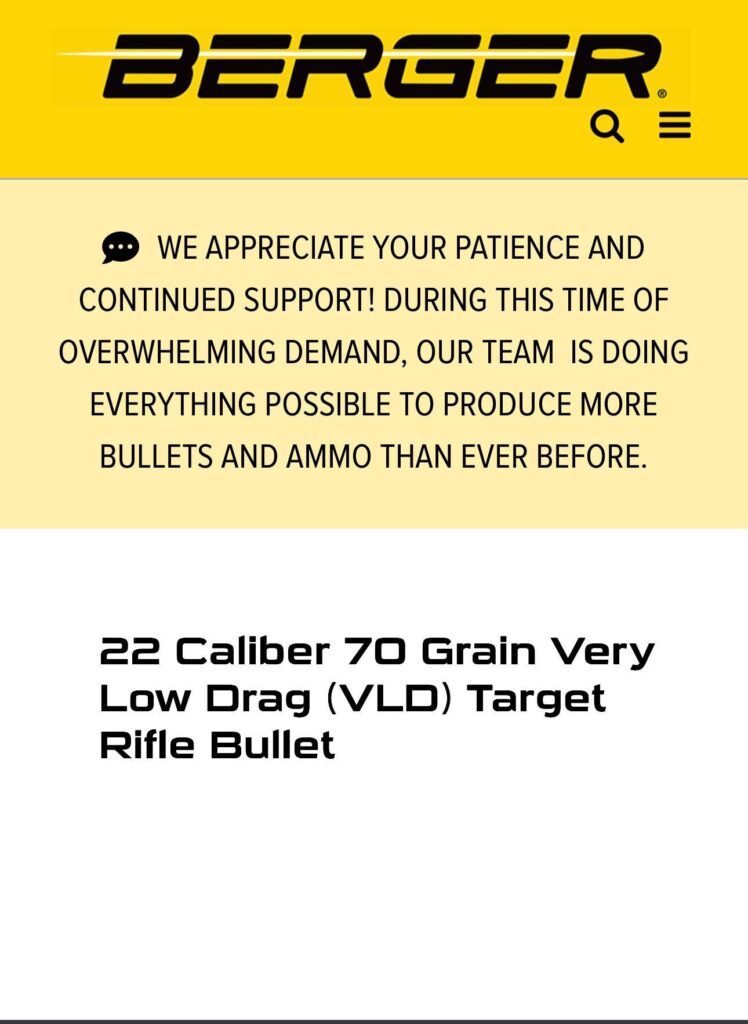I get a lot of questions about choosing bullets for coyotes in our most popular chambering, the .22 Creedmoor, so I thought I’d share what’s been working well for me and many of my customers.
My take up front: Coyotes are predators, not small varmints like prairie dogs or groundhogs. They need bullets that carry enough energy to transfer effectively for quick, clean kills. I start with bullets around 70 grains or heavier, sometimes a bit lighter if they’re designed tough enough. Lightweight bullets, like those below 70 grains built for varmints, often lack the energy and toughness needed for coyotes.
My go-to choices are the 80-grain Hornady ELD-X,
80-grain ELD-M, 70-80 grain Berger VLDs, and the
69-grain Sierra Tipped MatchKing. These bullets have tougher jackets that hold together and deliver high energy transfer, which is key for coyotes. On marginal hits, like the shoulder or hips, their sturdy construction lets them punch through bone if needed, ensuring the energy gets where it counts for a solid kill. Most of the big-number coyote guys I talk to swear by the 70-grain and 80-grain Berger VLDs for their accuracy and performance on predators, and I can see why-they’r a favorite for a reason.
To show the difference between heavier and lighter bullets, 1 compared an 80-grain Hornady ELD-X at 3300 fps to a 53-grain Hornady V-MAX at 4000 fps, a typical lightweight varmint bullet, both sighted in at 250 yards with a 2.75-inch scope height. Here’s how their bullet drop and retained energy stack up from 300 to 1000 yards:
- 300 yards: ELD-X drops -2.2 inches, ~1500 ft-los;
V-MAX drops -1.8 inches, ~900 ft-Ibs. - 400 yards: ELD-X drops -10.5 inches, ~1300 ft-Ibs;
V-MAX drops -9.0 inches, ~700 ft-Ibs. - 500 yards: ELD-X drops -22.5 inches, ~1100 ft-Ibs;
V-MAX drops -20.0 inches, ~550 ft-lbs. - 600 yards: ELD-X drops -39.5 inches, ~950 ft-Ibs;
V-MAX drops -36.0 inches, ~450 ft-Ibs. - 800 yards: ELD-X drops -90.0 inches, ~700 ft-lbs;
V-MAX drops -85.0 inches, ~300 ft-Ibs. - 1000 yards: ELD-X drops – 160.0 inches, ~500 ft-lbs;
V-MAX drops -155.0 inches, ~200 ft-Ibs.
Inside 250 yards, most bullets will work for coyotes if they stay together. Lightweight bullets like the V-MAX are a bit flatter, but past 300 yards, heavier bullets like the 80-grain ELD-X pull ahead. Its drop is close to the V-MAX, but it carries way more energy, which transfers better to the coyote for quicker kills. It also drifts less in a 10 mph crosswind (~62.0″ vs. ~85.0″ at 1000 yards), which helps in open country.
The 80-grain ELD-X is a great example, but the others perform just as well. The 80-grain ELD-M has similar energy retention and a tough jacket, transferring plenty of energy and punching through bone on tough shots like the shoulder or hips. The 70-80 grain Berger VLDs, as those high-volume coyote hunters often rave about, are super accurate with high ballistic coefficients, with strong jackets that hold up to bone impacts, delivering energy deep into the animal. The 69-grain Tipped MatchKing, though a bit lighter, has a robust design that transfers energy well and can penetrate bone when needed, balancing speed and toughness.
Heavier bullets like these are my choice for coyotes in a .22 Creedmoor. Their higher energy transfer and tougher jackets make them ideal for predators, especially on marginal hits where they can get through bone to deliver the energy needed for a clean kill.
Lightweight varmint bullets, like the 53-grain V-MAX and others below 70 grains, are great for smaller critters like prairie dogs, but their construction isn’t built for coyotes.
What bullets are you using for coyotes in your .22 Creedmoor? I’d love to hear what’s working for you
Thanks for the read!
God bless



